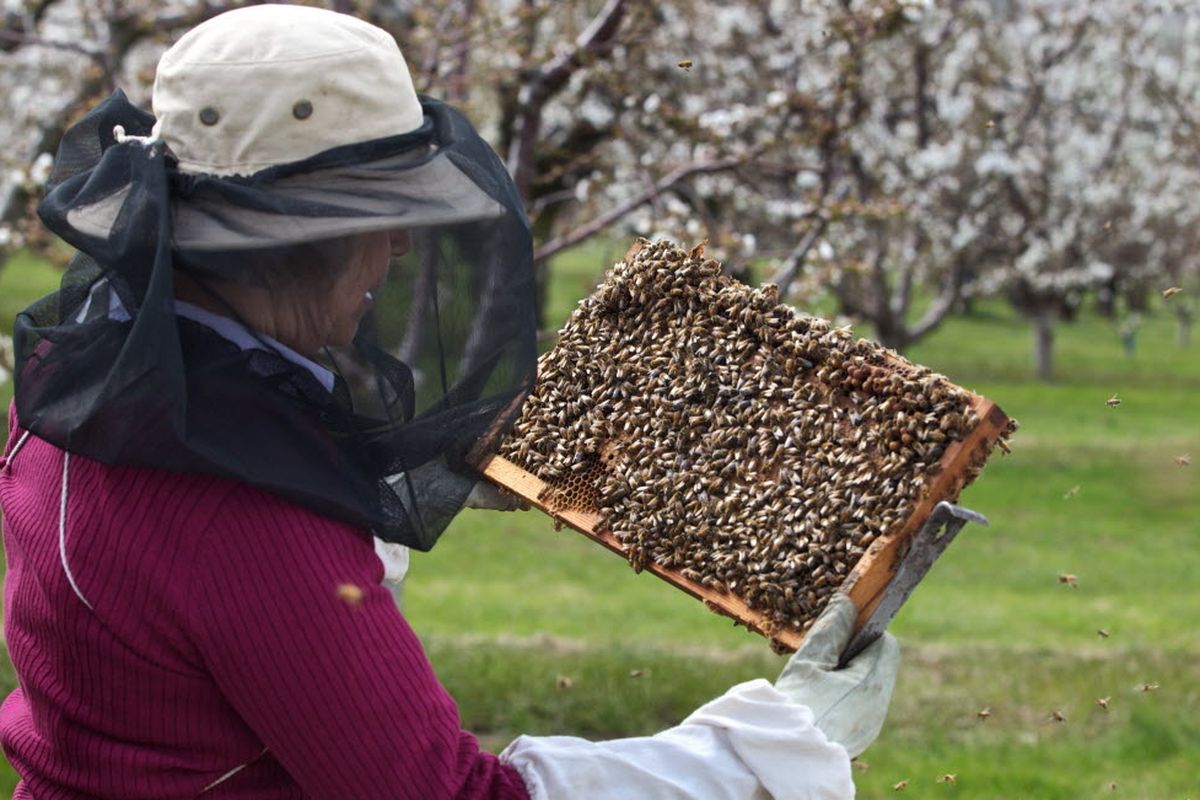Keepers work harder to keep hives healthy

PORTLAND – Jan Lohman points out the yellow smudge circling the entrance hole of a wooden beehive. Foraging bees returning to the hive bump clumsily against the entrance, staining it with pollen packed onto their legs.
“So they’ve already been out,” she said. “Looks like dandelion.”
The activity is a reassuring sight, showing all is normal. The colony and 2,000 others like it are ready for more work after being trucked here from central California, where they helped pollinate the vast almond orchards.
Lohman and her husband, Vince Vazza, are commercial beekeepers, and they spend the spring living in a travel trailer and moving honeybees from crop to crop. They begin with almonds in February, spend most of April in cherries, and work pears, blueberries, specialty vegetable seed fields and, finally, watermelon patches near home at Vazza Farms in Hermiston.
It’s a demanding circuit for bees and keepers alike. The stresses of travel, weather and uncertain bloom add to problems caused by pesticides, parasites and persistent pathogens. And hovering in the background is colony collapse disorder, which in the past six years caused hive losses of 30 to 90 percent.
It’s as mysterious as it is deadly. Adult bees disappear from the hive, often leaving behind a live queen, food and immature brood. Bees aren’t found dead in or around the hive; they’re simply gone. There are no workers to tend to the queen and her brood.
The Northwest hasn’t been hammered as badly as other regions, but hive losses have spiked. A 10 percent hive loss over winter previously was considered normal, but losses the past few years ranged from 29 to 37 percent, said George Hansen, a Colton, Ore., commercial beekeeper and president of the American Beekeeper Federation.
Hansen owns Foothills Honey Co. and travels the pollination circuit with 5,000 hives.
Much is at stake.
Bees pollinate while gathering nectar and pollen for the colony. The unintended benefit to farmers is critical: It increases the yield and value of crops nationally by an estimated $15 billion annually. The almond crop alone requires 1.5 million colonies – half the nation’s honeybees.
In Oregon, about 56,000 colonies pollinate cherries, blueberries, apples, pears and other crops. Blueberry and cherry crops depend on commercial bees for about 90 percent of pollination.
“It’s huge, it’s everything,” said fourth-generation cherry grower Brenda Thomas, president of Orchard View Farms in The Dalles, Ore. “We count on the bees.”
Beekeepers benefit as well. A 2009 Bee Pollination Economics Survey estimated Northwest beekeepers may gross $90 million in hive rental income annually. The U.S. Department of Agriculture survey estimated the average fee at $89 per hive, with many crops requiring two per acre.
At the same time, the number of managed beehives in the U.S. is about half what it was in the 1940s, according to the Agriculture Department. Oregon has about two dozen commercial beekeepers of significant size, with about 5,000 nationally. Those willing to travel reportedly can command $150 per hive working the almond orchards in California.
Beekeepers say they’re working harder to keep bees healthy. Bees have serious enemies, the most deadly being tiny varroa mites, which suck bees’ blood, weakening the colony and providing a pathway for viruses.
“Mites are costing us more than anything else,” said Hansen, the Colton beekeeper. “Right now we don’t have an effective control, just a mishmash of home remedies and guesstimates.”
Other dangers include tracheal mites, which clog bees’ breathing tubes, and a gut parasite called nosema. Neither explains colony collapse, however. Researchers believe a combination of factors may be to blame, including overcrowding, a lack of nutritional variety due to mono-crops, and contaminated water.
Increasingly, keepers and scientists question pesticides.
“Everybody has a favorite culprit,” Hansen said. “I don’t want to say it’s caused by pesticides, but they’re not doing us any good.”
Vazza Farms, now working cherry orchards in The Dalles, has avoided massive colony losses, but Vince Vazza said hives require more care to keep them healthy. Among other steps, he and Lohman install new queens every year. Queens live three to five years, but replacing them annually appears to invigorate the hive.
Even after 35 years in the business, Vazza takes pride in having active, healthy bee communities.
“There’s a wholeness to it that’s real special,” he said.
With a little more sun, their bees will have plenty to do in the Columbia River Gorge as about 10,000 acres of cherry trees pop with flowers. But this afternoon it’s chilly and damp, blossoms are slow to open, and hungry honeybees will have to do with bright yellow dandelions growing between the orchard rows.